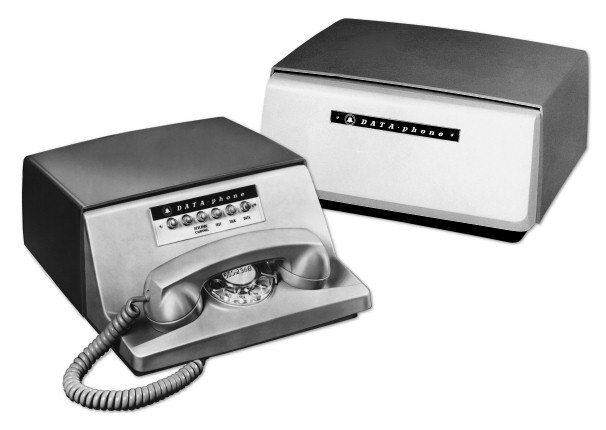300-baud modem
Superseding the short-lived Bell 101 modem, the Bell 103 modem introduced in 1962 set the standard for networked computer communication for years to come. The technology was developed, as its name indicates, at Bell Labs, and was released by AT&T for public use in 1962. The 103 was a commercial modem which was the first to have full-duplex transmission and frequency-shift keying. It had a speed of up to 300 bits per second. This slow speed led to a possibly apocryphal saying amongst Bell engineers was that modems implementing this standard would, in fact, work over barbed wire (Driscoll 2015).
Communication technologies that utilized the 103 modem included local networks at universities, which ran on phone lines and connected via a bed on the terminal on which was placed a telephone handset (Kuehn 2012). To encode data over these lines, the modem utilized an audio frequency-shift keying system, where different frequencies were used by the originating and receiving modems as mark tones and space tones. The audio-centric properties of the modem are a prominent cultural referent, but they also allowed for a harkening back to the text-based instantaneity of wired and wireless telegraphy.
This modem was initially used to transmit data between mainframe computers and screenless print-out terminals. It remained in use throughout the 60s, 70s, and 80s; and later modems were backwards-compatible with the 103’s signaling band. By 1984, 300-type modems dominated the market, because they were affordable as well as compatible with popular applications, such as email and bulletin boards (Kline 2020). Higher speeds were needed to do things like download photos, but the infrastructure was not there yet to make that a possibility.
The affordable, consumer-grade modem was the technology that allowed for the overall uptake of networked computer-to-computer communication throughout the middle of the 20th century. Modems “represented a meeting point between the novel and legacy systems of personal computing and telephony” (Driscoll 2015) and made legible the noise of the signal over the phone lines already eliminating distance.
Kline, R. R. (2019). The Modem that Still Connects Us. In Historical Studies in Computing, Information, and Society. Springer.
Kuehn, L. (2012). No More “Digital Natives” and “Digital Immigrants.” In Our School/Our Selves.

